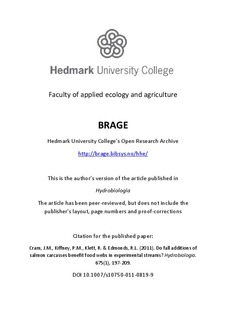| dc.identifier.citation | Cram, J.M., Kiffney, P.M., Klett, R. & Edmonds, R.L. (2011). Do fall additions of salmon carcasses benefit food webs in experimental streams? Hydrobiologia. 675(1), 197-209. | en_US |
| dc.description.abstract | Research showing that salmon carcasses support the productivity and biodiversity of aquatic and riparian ecosystems has been conducted over a variety of spatial and temporal scales. In some studies, carcasses were manipulated in a single pulse or loading rate or manipulations occurred during summer and early fall, rather than simulating the natural dynamic of an extended spawning period, a gradient of loading rates, or testing carcass effects in late fall-early winter when some salmon stocks in the US Pacific Northwest spawn. To address these discrepancies, we manipulated salmon carcass biomass in 16 experimental channels located in the sunlit floodplain of the Cedar River, WA, USA between mid-September and mid-December, 2006. Total carcass loads ranged from 0–4.0 kg/m2 (0, 0.001, 0.01, 0.1, 0.5, 1.0, 2.0 and 4.0 kg/m2, n = 2 per treatment) and were added to mimic the temporal dynamic of an extended spawning period. We found little evidence that carcasses influenced primary producer biomass or fish growth; however, nutrients and some primary consumer populations increased with loading rate. These effects varied through time, however. We hypothesize that the variable effects of carcasses were a result of ambient abiotic condition, such as light, temperature and disturbance that constrained trophic response. There was some evidence to suggest peak responses for primary producers and consumers occurred at a loading rate of *1.0–2.0 kg/m2, which was similar to other experimental studies conducted during summer. | en_US |
